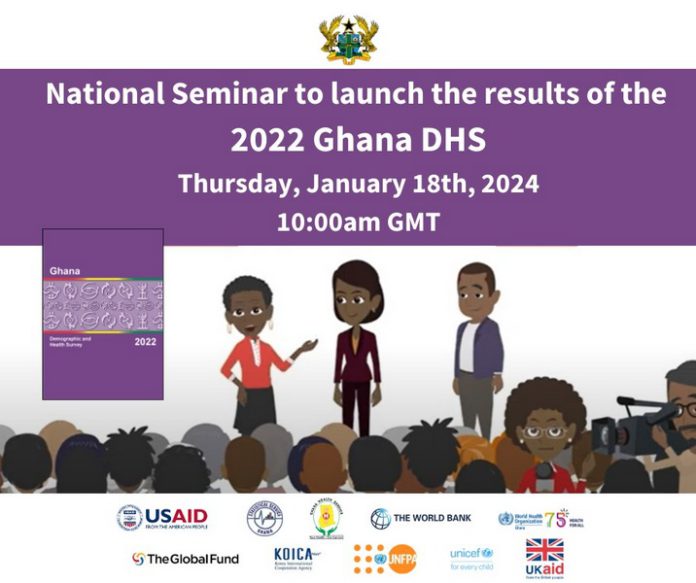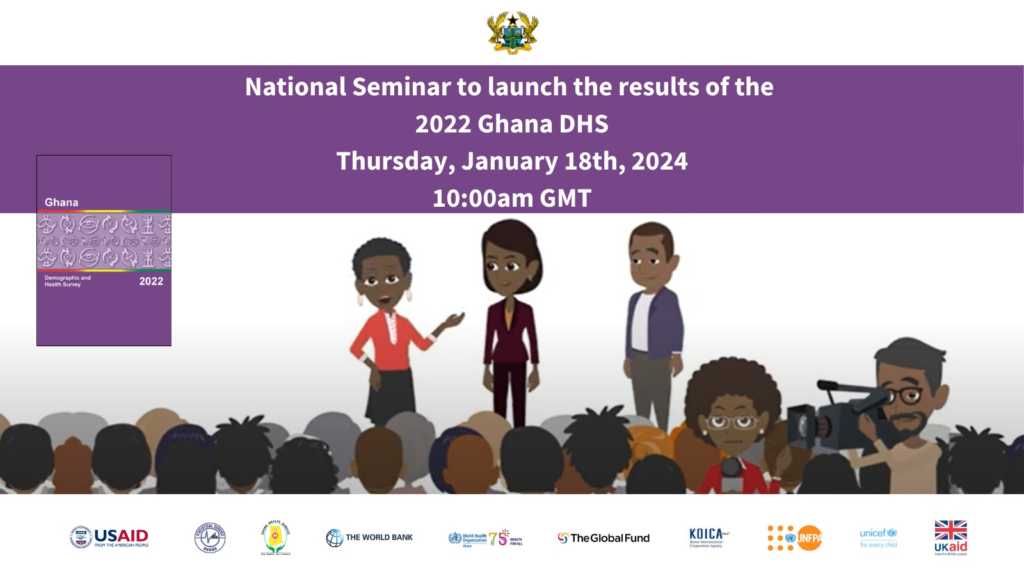
The main report of the 2022 Ghana Demographic and Health Survey (GDHS) was launched in Accra on Thursday, 18th January 2024.
The report was jointly launched by Prof. Samuel Kobina Annim, the Ghana Statistician; Dr. Patrick Kuma-Aboagye, the Director-General of the Ghana Health Service; Dr. Zohra Balsara, USAID Ghana Health Office Director; and a representative of Prof. Francis Kasolo, WHO Ghana Representative.
The launch marks the beginning of a series of dissemination activities aimed at engaging key stakeholders involved in policy decision-making, planning, monitoring, and evaluation.

During the event, the Government Statistician, Prof. Samuel Kobina Annim, presented highlights from the GDHS Main Report and concluded with the following takeaways:
- From the access and behavior viewpoints, health improvements are a shared responsibility between individuals and the state. With respect to health-seeking behavior, for instance, about one-third (32.4%) of women aged 15 to 49 visited a health facility or health provider in the six months preceding the survey, while one-fifth of men in this age range (20.4%) did so.
- There is evidence of retrogression in some health indicators over time. For instance, childhood vaccination coverage remains lower than in previous surveys. Currently, 75% of children are vaccinated against all basic antigens, which is a decrease from 79% in the 2008 GDHS. The 2022 GDHS also shows a slight increase in the percentage of children with no vaccinations, from 1% in the 2008 GDHS to 2% in 2022. Sexual violence increased by 1.1 percentage points between 2008 and 2022.
- Regional variations are stark across several health indicators. Childhood mortality rates by region vary considerably. For example, regions with the highest under-5 mortality rates for the ten-year period before the survey are Oti and Savannah (72 and 63 deaths per 1,000 live births, respectively), while Ahafo and Greater Accra regions have the lowest under-5 mortality rates (29 and 20 deaths per 1,000 live births, respectively).
- Wealth and education remain key drivers in addressing health challenges at the individual level. Examples of health indicators that increase with maternal education and household wealth quintile are malaria and stunting in children under 5 years, while conversely, obesity increases with education and wealth.
- Based on the findings of the report, it is evident that achieving the Sustainable Development Goals 2, 3, and 5 targets will require the acceleration of efforts and investments.
The 2022 Ghana Demographic and Health Survey (GDHS) was conducted by the Ghana Statistical Service, in collaboration with the Ministry of Health, Ghana Health Service, and other stakeholders, with funding from the United States Agency for International Development (USAID) and other partners.
The data collected by the survey will support the design, implementation, monitoring, and evaluation of policies and programs to improve population health and well-being, and reproductive, maternal, and child health.
The main and summary reports of the 2022 GDHS can be downloaded from www.statsghana.gov.gh, and the microdata are available for download at no cost from https://statsghana.gov.gh/gssdatadownloadspage.php.

